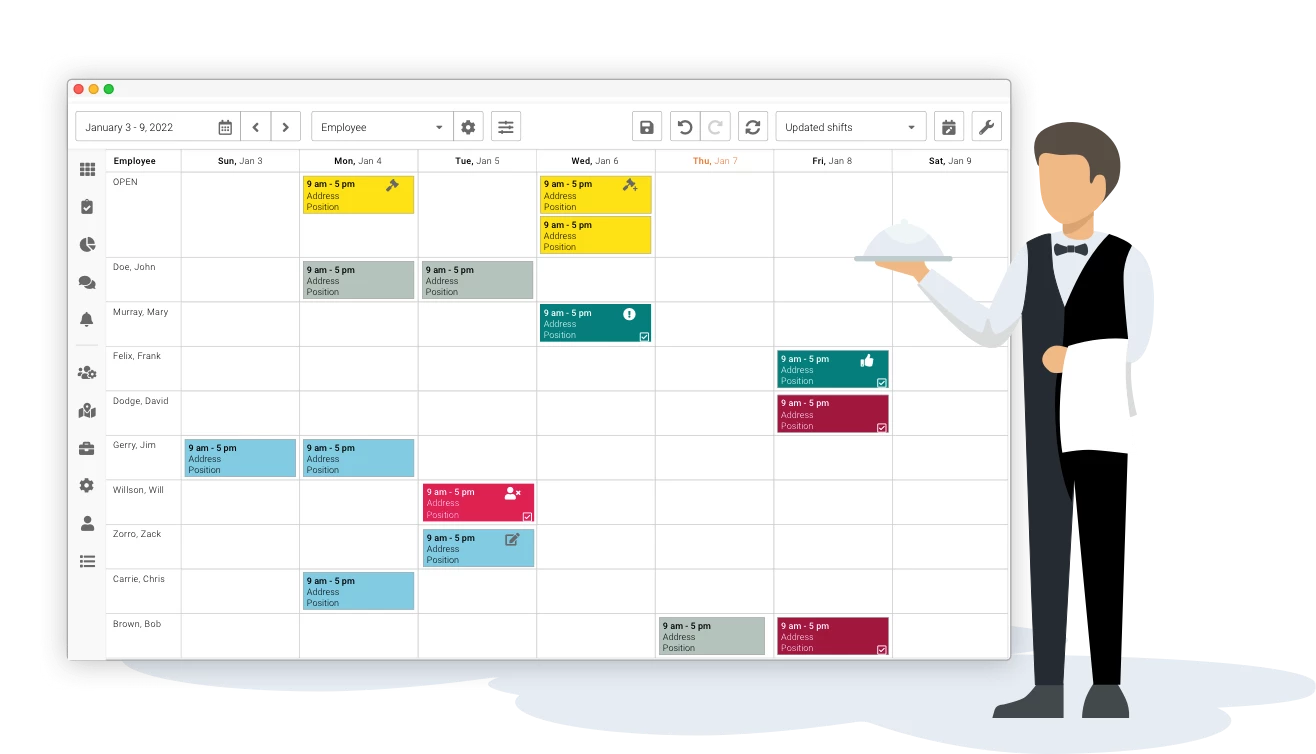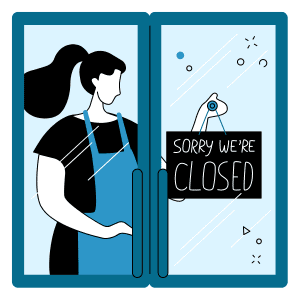In the dynamic world of restaurant management, striking the right balance between efficient staffing and employee well-being is a constant challenge. One of the often-overlooked challenges is the practice of “clopening” shifts, a term derived from “closing” and “opening” shifts.
This blog post will delve deep into the hidden costs associated with clopening shifts, shedding light on how it impacts both employees and businesses. We will also explore how employee scheduling software can play a pivotal role in addressing these challenges and ensuring a healthier work environment for everyone involved.
Understanding Clopening Shifts
Clopening shifts refer to a work schedule in which an employee closes a shift late at night and then opens another shift early in the morning. This leaves them with minimal time for rest between shifts. While this practice may appear to be a cost-effective way to manage staff, the hidden costs of scheduling clopening shifts can be substantial and detrimental to your business.
Why do Employers use Clopening shifts?
Employers may use clopening shifts for several reasons, although it’s important to note that this practice is often controversial and can have negative impacts on employees. Here are some reasons why employers may choose to implement clopening shifts:
- Cost Control: Clopening shifts can help employers reduce labor costs by minimizing the number of shifts that require additional staffing. Since the same employee is closing and opening, there’s no need to pay two different employees for those shifts.
- Scheduling Flexibility: In industries with fluctuating demand, such as retail and food service, clopening shifts may provide employers with scheduling flexibility to meet changing customer needs without hiring more staff.
- Employee Availability: In some cases, employers may use clopening shifts because they have limited staff availability during certain hours. Clopening allows them to cover shifts when they may not have enough employees available.
- Staffing Shortages: When employers face staffing shortages due to unforeseen circumstances, such as last-minute call-offs or unexpected busy periods, they may resort to clopening shifts as a temporary solution to ensure the business remains operational.
- Lack of Awareness: Some employers may not fully understand or appreciate the negative effects of clopening shifts on their employees’ well-being and performance. They may use this scheduling practice without realizing its impact.
In recent years, there has been a growing awareness of the negative effects of clopening shifts on employees, leading to increased scrutiny and efforts to improve scheduling practices in various industries. But what exactly
are the costs of clopening shifts?
What are the Hidden Costs of Clopening Shifts?
Hidden Cost #1: Employee Burnout
One of the most significant hidden costs of clopening shifts is employee burnout. Consistently working irregular hours with insufficient rest or lack of sleep can lead to physical and mental exhaustion. Over time, burnout can result in reduced job satisfaction, higher turnover rates, and decreased overall productivity among your staff. Burnout can also lead to other health issues for employees, and impact their mental health.
Hidden Cost #2: Decreased Employee Performance
Clopening shifts often lead to poor job performance. The fatigue and sleep deprivation associated with these shifts can result in reduced attention to detail, slower reaction times, and an increased likelihood of errors. This not only affects the customer experience but can also harm the restaurant’s reputation.
Hidden Cost #3: Increased Turnover
The combination of burnout and decreased performance frequently results in higher employee turnover rates. Employees who feel overworked and undervalued are more likely to seek employment elsewhere. Recruiting and training new staff members can be costly and time-consuming, putting a strain on your resources.
Alternatives to Clopening Shifts
There are several alternatives to clopening shifts that employers can consider to create more employee-friendly and balanced work schedules while still meeting business needs. These alternatives aim to improve employee well-being, reduce turnover rates, and enhance overall job satisfaction. Here are some alternatives to help you avoid clopening shifts:
Advanced Scheduling Software:
Employee scheduling software can help employers create more efficient and fair schedules. These tools consider employee availability, preferences, and labor laws to generate balanced schedules that reduce the need for clopening shifts. We’ll look at this in more detail later.
Cross-Training:
Cross-training employees in different roles or positions can provide greater scheduling flexibility. When you have a team of employees who can perform various tasks, it becomes easier to fill shifts without relying on the same person for back-to-back shifts.
Split Shifts:
Instead of having one employee work a clopening shift, consider splitting the shift into two parts with a longer break in between. This provides employees with a chance to rest and recover before returning for their next shift.
Staggered Shifts:
Staggered shifts involve scheduling employees to start and end their shifts at different times. This approach can help distribute work hours more evenly among your staff, reducing the need for clopening.
Part-Time Employees:
Hiring more part-time employees can help distribute work hours and reduce the need for long or irregular shifts. Part-time workers can fill gaps in the schedule without overburdening full-time employees.
Flexible Scheduling:
Implementing flexible scheduling options, such as offering compressed workweeks, self scheduling, or job-sharing arrangements, can provide employees with more control over their work schedules and reduce the need for clopening.
On-Call Staff:
Having a pool of on-call or backup staff who can be called in when needed can help cover unexpected staffing gaps without relying on clopening shifts.
Predictive Scheduling:
Some jurisdictions have implemented predictive scheduling laws that require employers to provide employees with advance notice of their work schedules. Compliance with these laws can reduce the occurrence of last-minute clopening shifts.
Employee Feedback:
Encouraging open communication with employees and seeking their input on scheduling preferences and concerns can help identify scheduling issues early and find solutions together.
Work-Life Balance Initiatives:
Implementing initiatives that promote work-life balance, such as providing paid time off, wellness programs, and employee assistance programs, can help employees manage their well-being even when facing challenging work schedules.
It’s important for employers to prioritize their employees’ well-being while also ensuring that business needs are met. By adopting some of these alternatives to clopening shifts, employers can create a more employee-friendly and sustainable work environment while maintaining operational efficiency.
How can Employee Scheduling Software Help?
To address the hidden costs associated with clopening shifts and promote a healthier work environment, many restaurants are turning to employee scheduling software. Here’s how this powerful tool can make a significant difference:

1. Efficient Schedule Management
Employee scheduling software empowers restaurant managers to create balanced and predictable schedules. By optimizing shifts based on employee availability and preferences, it significantly reduces the likelihood of clopening situations.
2. Fair Distribution of Shifts
With the help of scheduling software, managers can ensure that shifts are distributed fairly among all employees, preventing the burden of clopening from falling on specific individuals. This fosters a sense of fairness and equity in the workplace. For example, Celayix offers tools such as a autofill and our AI scheduler which help promote fairness in the scheduling process.
3. Improved Communication
Modern scheduling software often includes features for communication and schedule management. This enables team members to collaborate on managing their schedules, making it easier to avoid undesirable clopening shifts. Celayix has a great employee scheduling app that notifies employees of their schedule and allows them to drop/pick up shifts as needed.
4. Data-Driven Insights
Employee scheduling software provides valuable insights into labor costs and staffing efficiency. Managers can make informed decisions to further optimize schedules, reducing labor costs while prioritizing employee well-being.
5. Compliance with Labor Laws
Scheduling software can help ensure compliance with labor laws and regulations related to working hours and rest periods. This reduces the risk of legal issues and fines associated with scheduling violations.
While clopening shifts may initially seem like a cost-effective scheduling strategy, the hidden costs can take a toll on both employees and your restaurant’s bottom line. To strike a balance between efficient staffing and employee well-being, consider investing in employee scheduling software. By leveraging technology to create fair, predictable schedules, you can mitigate burnout, enhance performance, and ultimately cultivate a healthier and more productive work environment within your restaurant.
Make the shift toward employee scheduling software today to ensure a brighter future for your staff and your business. By doing so, you’ll not only reduce hidden costs but also promote a workplace culture that values the well-being of its employees, leading to long-term success and sustainability. If you currently rely on clopening shifts and you’d like to change that, get in touch with Celayix today to arrange a custom live demo!









